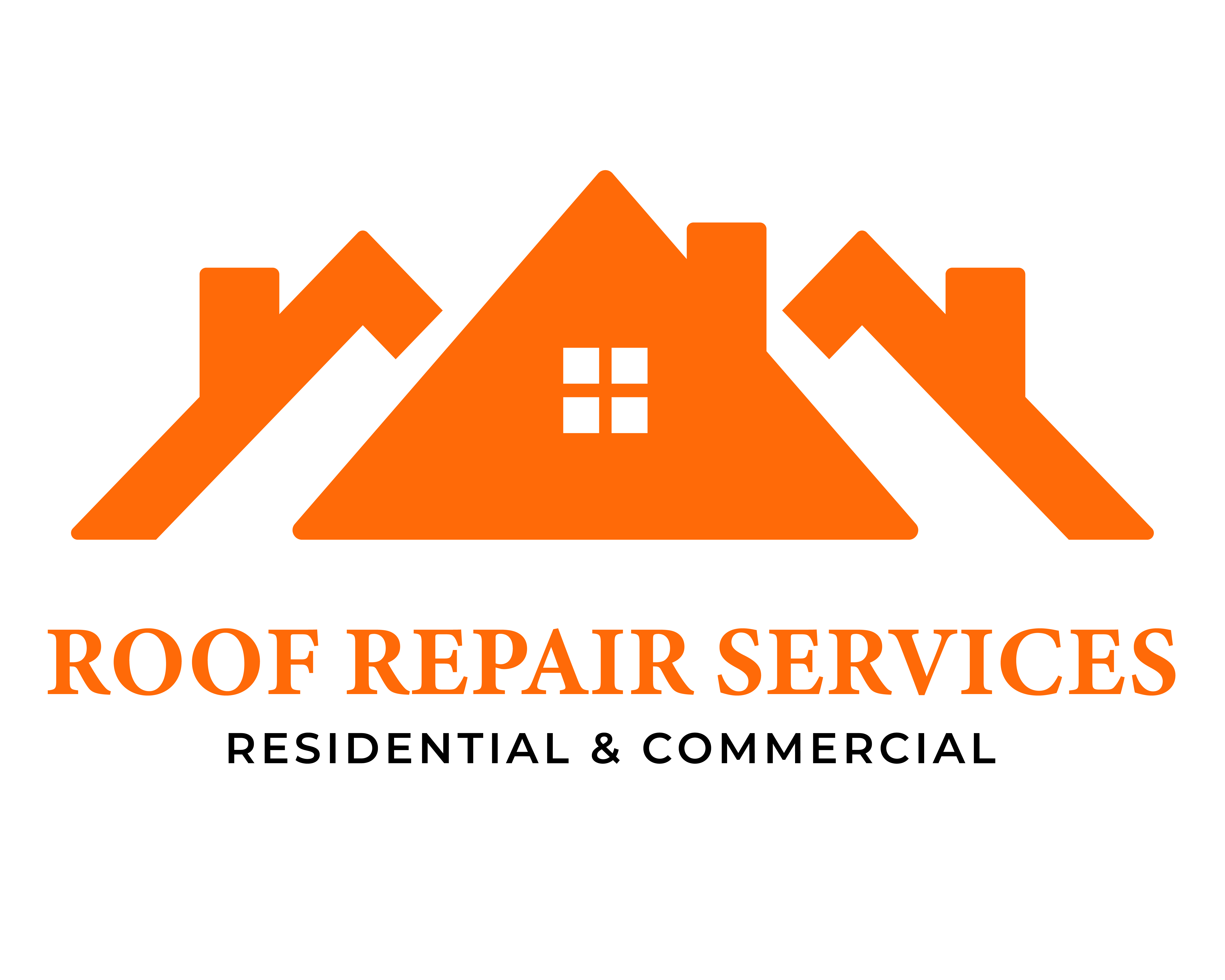Emergency Roof Repairs: Quick Fixes to Protect Your Home - Roof Repair Services
- Home
- Emergency Roof Repairs: Quick Fixes to Protect Your Home
Car Repairing
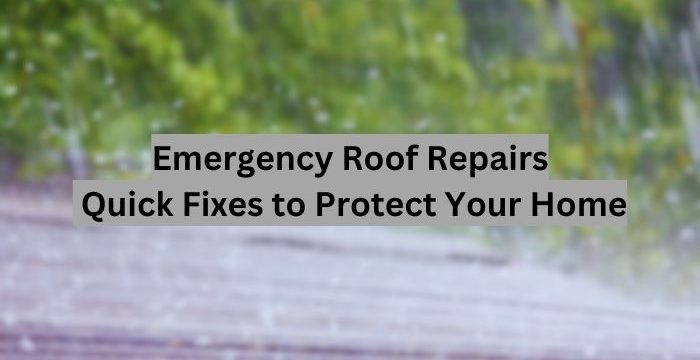
- July 15, 2024
- By: roofrepair_admin
- General
- Comments: 0
Emergency Roof Repairs: Quick Fixes to Protect Your Home
This guide on emergency roof repairs offers rapid solutions to secure your home and shield it from leaks and additional harm. Discover how to spot damage and implement temporary measures that will keep your dwelling protected during an emergency situation with the roof.
Key Takeaways
- Prompt identification and assessment of roof damage, employing safety-first inspection techniques, is crucial for timely and effective emergency repairs.
- Implementing immediate safety measures, such as deciding between DIY fixes and professional help, ensures both the safety of household members and efficient damage control.
- Employing temporary fixes like roofing cement, securing loose shingles, and using tarps can mitigate further damage while awaiting professional roofing repairs.
Identifying Roof Damage Quickly
In situations requiring emergency roof repair, quick action is crucial. Promptly detecting and rectifying any damage to the roof increases the likelihood of averting expensive repairs and preserving your home’s structural integrity during emergency roof repair scenarios.
We shall delve into common signs of damage to roofs along with effective techniques for assessing how serious such issues may be.
Common Signs of Roof Damage
Monitoring your roof closely can prevent unwanted surprises and costly fixes. Obvious signs that suggest the need for prompt repairs include shingles that are either absent or impaired, water marks on the ceiling below, and a drooping appearance of the roof itself. Such visible cues typically signal deeper problems that should be addressed swiftly.
Don’t dismiss subtle hints as well. In situations involving a leaky roof, you might come across:
- Accumulated water in your attic
- Substantial pools of water atop your roofing
- Light piercing through gaps in roofing planks
- Shingles being thrust upward by gusty winds revealing what lies beneath
- Weathered flashing near structural protrusions like chimneys or vents
- Cracks or buckles in shingle surfaces
- Deposits of fine particles from shingles collecting within gutters
All these scenarios suggest an urgent need to repair your rooftop before harm ensues.
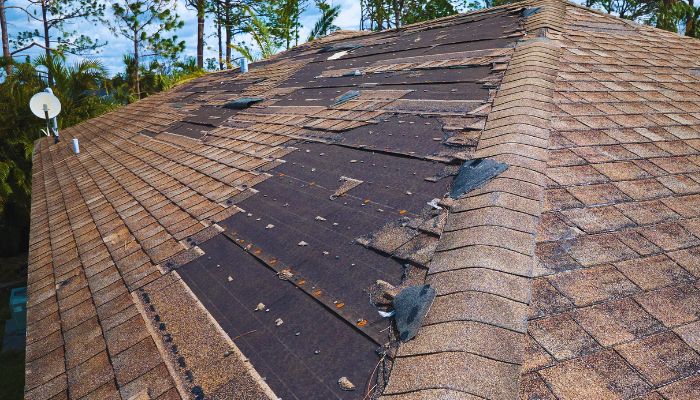
Assessing the Extent of Damage
When you suspect that your roof has sustained damage, it is crucial to assess how critical the condition might be. Kicking off the emergency roof repair process with a comprehensive inspection allows for determining just how extensive the damage is and what kind of repairs will be required. Gathering this information sets priorities in place and directs you toward subsequent steps.
Maintaining safety should always take precedence throughout these initial stages. Rather than risk climbing up onto potentially unstable roofing structures, consider using binoculars as a precautionary means for inspecting at a distance. Scope out for telltale signs such as missing shingles or clear indications of leaks and sagging sections of the roof surface. If circumstances permit safely doing so, Investigation within your attic space can reveal additional evidence of leaking, like damp insulation or staining on rafters, yet do so without compromising personal safety because accumulating knowledge about potential emergency roof issues should not come at unnecessary personal risks.
Immediate Safety Measures
In the event of a roofing emergency, keeping your composure is crucial. Remaining calm and collected will allow you to manage the situation better, avoiding added stress or haste-induced mistakes. The primary concern should be the wellbeing of everyone within your residence while simultaneously acting to limit any additional damage.
We aim to clearly outline vital safety precautions and assist in determining if it’s appropriate for your own hands-on intervention or if professional assistance is warranted.
Prioritizing Safety
As soon as you detect an emergency involving a roof leak, immediately prioritize the safety of yourself and your loved ones. Carefully assess whether it’s safe to stay within the residence or if the extent of damage necessitates vacating the area. When faced with considerable structural damage, opting for caution and vacating until a professional can evaluate is advisable.
Should you determine that staying put to conduct initial repairs is secure, don’t overlook personal protective gear. Utilizing safety equipment isn’t exclusively reserved for professionals—anyone addressing issues with their roof should have this protection. Equip yourself with solid gloves to fend off any cuts from sharp materials, shoes designed to prevent slipping for stable footing, and goggles to protect against flying particles. Always remember: safeguarding oneself surpasses rushing into a fix without proper precautions since no repair task justifies compromising your own safety.
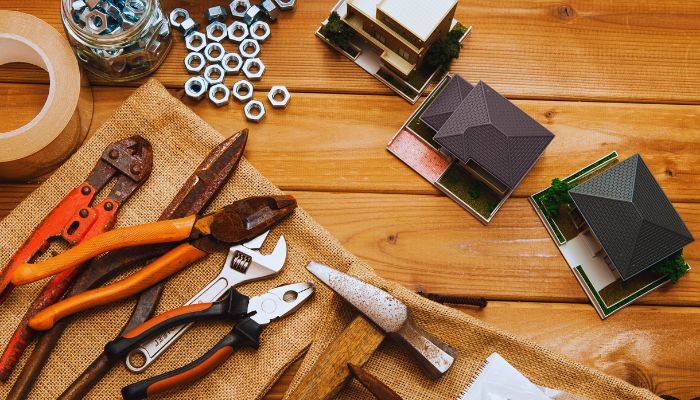
Deciding Between DIY and Professional Help
In the midst of a roofing emergency, you might consider handling the fix on your own. It’s crucial to pause and contemplate whether self-repair is truly wise. Before diving into any repair efforts, remember there’s risk involved. Without appropriate skills and tools, personal injury or additional roof damage could occur. Roof repair work becomes even more hazardous in emergencies due to factors like inclement weather.
Calling in experts is essential under certain circumstances rather than simply advisable – particularly when severe storms or strong winds have inflicted significant harm. Experienced professionals come equipped with specialized knowledge and gear necessary for accurately evaluating and fixing such problems while maintaining safety standards—ensuring that your rooftop returns to its former reliability smoothly and efficiently. Trustworthy services offering emergency roof repairs tend to maintain reasonable pricing structures despite urgent needs.
Should uncertainties arise about how best to manage an emergency roof situation, opt for professional help instead of going it alone. Doing so can prevent wasted resources as well as unnecessary stress over time by ensuring issues are addressed correctly from the start.
Quick Temporary Fixes for Roof Leaks
When faced with roof leaks, it is crucial to respond quickly. While permanent resolution typically necessitates professional repairs, there are effective temporary solutions that can help mitigate Damage to your property in the interim. This section will discuss three expedient methods for addressing emergency leaks: applying roofing cement and sealants, utilizing tarp coverings, and employing emergency patching strategies. These measures provide a stopgap until you can secure professional assistance.
Using Roofing Cement and Sealants
Roofing cement and sealants stand as the go-to allies for swiftly addressing roof leaks, acting as a sturdy shield against the elements during temporary mending endeavors. Silicone caulk shines with versatility. It can be administered straight to the leak’s origin point. Prior to caulking, prep by tidying up around the leakage zone, then smoothly dispense a continuous strip of silicone ensuring full envelopment of the compromised site.
Should you seek an even more substantial interim measure, opt for plastic roofing – a dense material similar to putty that is deployable via either a putty knife or caulk gun—fashioning an impervious layer covering extended patches. In applying this type of cement, prioritize uniform distribution while embedding firmly within any crevices or openings. For bolstered defense layer on top tar paper above your application and smoothen thoroughly eliminating potential pockets of air.
Despite their reliability in temporarily stopping water ingress through roofs, these interventions should not be misconstrued for long-term solutions. Hence anticipate scheduling maintenance from qualified technicians who will ultimately provide thorough repairs without delay.
Dealing with Loose or Damaged Shingles
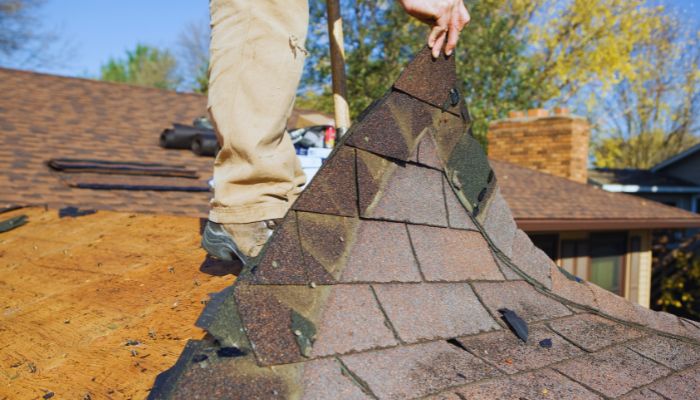
Damaged or loose shingles frequently lead to roof leaks and, if not tended to promptly, can develop into more significant issues. Addressing these concerns swiftly can avert Damage from water infiltration on your roof, thus helping you dodge expensive repairs in the future.
In this segment, we will provide instruction on identifying shingles that are loose and strategies for fastening them down. This serves as an interim fix while awaiting the arrival of professional assistance.
Identifying Loose Shingles
To tackle the issue of unsecured shingles, first learn to identify them. Conduct an inspection from a safe position on the ground or use a ladder if you can do so safely. Be on the lookout for:
- Shingles that seem displaced
- Shingles with raised edges
- Absent shingles
These signs indicate immediate attention is necessary for your roof’s covering. Indicators include shingle surfaces that are:
- Fractured
- Turning up at the perimeter These symptoms suggest degradation and imminent breakdown.
Spotting granules in gutters or near downspout bases is another clear sign of failing shiles. This gritty surface layer protects asphalt shingles but when they start shedding it excessively, this implies that your tiles are wearing out. As they lose their granular coating—a process similar to balding—shigles become more vulnerable to wind and moisture damage.Inspecting these elements regularly allows early detection of issues which helps avoid more severe harm to your roof’s structure.
Securing Loose Shingles
Securing loose shingles is a critical step in avoiding additional roof damage and the risk of water getting inside your home. Completing this task effectively necessitates meticulousness and suitable equipment, such as:
- Roofing nails
- Hammer
- Roofing adhesive
- Caulking gun
Ensure you wear appropriate safety attire, including shoes with good traction and protective gloves, before beginning any repair work.
To fasten down a loose shingle accurately, execute the following actions:
- Carefully elevate the shingle.
- Underneath it, apply an ample layer of roofing adhesive.
- Firmly press the shingle back to its original position.
- Utilize roofing nails for firm anchorage.
- Overlay the heads of nails with a bit of roofing cement for extra defense against moisture entry.
When faced with either a damaged or absent shingle, complete replacement might be necessary. Insert a new one into place then secure firmly using both roofing nails and adhesive agents alike.While implementing these measures can serve as effective temporary remedies, they should not be misconstrued as lasting solutions.Prioritize arranging for examination by a professional roofer who can ensure proper, long-term repairs are carried out without delay.
Mitigating Interior Damage
Dealing with the exterior part of your roof is essential, but it’s just as critical to handle any damage inside that has resulted from leaks. Taking immediate measures can halt water progression and prevent extensive harm to both the structural integrity of your home and your personal items. In this segment, we will introduce efficient techniques for managing water intrusion and protecting your belongings amidst a roofing emergency.
It’s important to keep in mind that these actions are interim solutions designed to lessen potential destruction while awaiting professional repairs.
Containing Water Damage
The moment you notice water seeping into your home from a roof leak, it’s time to spring into action. To begin, follow these steps:
- Place buckets or containers under any active leaks to catch dripping water. This will help prevent further water damage.
- This simple action can prevent water from spreading across your floors and causing more extensive damage.
- For larger affected areas, consider using protective plastic sheeting to cover furniture and floors, directing water into your collection containers.
If you’re dealing with a significant amount of water, you may need to take more aggressive measures. Here are some steps you can take.
- Use towels to soak up excess water.
- If available, employ a water pump to remove water from the area.
- It’s crucial to dry wet areas as quickly as possible to prevent mold growth and further structural damage.
- A dehumidifier can be incredibly helpful in reducing moisture levels in the affected rooms.
If you notice your ceiling bulging with collected water, carefully poke a small hole to release the leak in a controlled manner. This can prevent a sudden collapse and allow you to manage the water flow more effectively.
Protecting Valuables
Ensuring that water is contained during a roof leak emergency is essential, but it’s just as imperative to safeguard your valuable belongings. Promptly survey the area impacted by the leak and pinpoint items at risk of being ruined by moisture. Such items may include:
- furnishings
- electronic devices
- vital paperwork
- prized personal possessions
Your immediate aim should be to transfer these objects to an area untouched by water as quickly as possible in order to avoid any damage caused by moisture.
For bulky or unwieldy objects like large furniture or fixed electronics that can’t easily be relocated, deploying waterproof materials for protection is advisable. Utilizing plastic sheets or tarps can serve effectively in creating a temporary yet efficient barricade against Water infiltration. Remember too that walls and floorings are susceptible. They could undergo serious harm from contact with water. Wrap up any exposed sections of these surfaces using extra tarpes—or even trash bags—as safeguards in areas where the drip has direct impact.
By undertaking this preventive action focused on shielding both your precious goods and interior structures of your abode, you stand to considerably lower potential expenses due to damages while awaiting professional repairs.
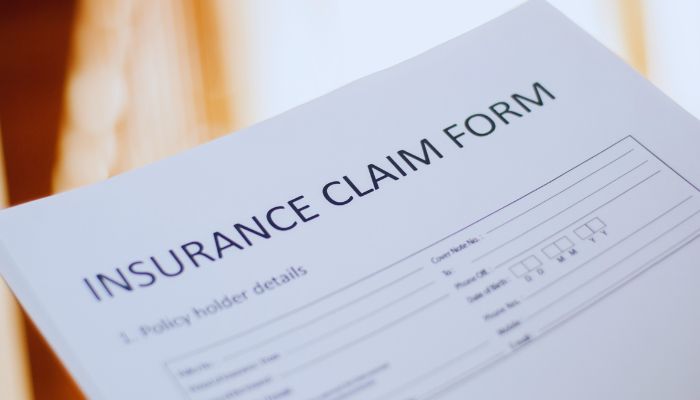
Documenting Damage for Insurance Claims
When confronted with a roofing emergency, the urgency of the situation may cause you to neglect proper documentation. Accurate and detailed records of roof damage are vital when filing insurance claims and can greatly influence the economic side of your roof repairs. Meticulous records assist in evaluating the extent of the damage while also speeding up the process for your insurance claim, thereby confirming that you obtain adequate compensation for repair costs.
In this segment, we will delve into crucial procedures necessary for efficiently recording instances of roof damage.
Taking Photos and Videos
When it comes to documenting roof damage, the old saying “a picture is worth a thousand words” couldn’t be more accurate. Start your documentation process by capturing detailed photographs and videos of the damage. Here’s what you should do:
- Begin with exterior shots, including wide-angle views of your roof.
- Take close-ups of specific damaged areas.
- Don’t forget to photograph any fallen debris or tree limbs that may have caused the damage.
Next, move inside and document any interior damage caused by the roof leak. This might include water stains on ceilings, wet insulation in the attic, or damage to personal property. When taking photos, try to maintain a consistent order, such as starting from the exterior and moving to the interior. This organized approach will help insurance adjusters understand the full scope of the damage.
Remember to take photos of all damage before any repairs start, as this will provide a clear record of the initial state of your roof. The more comprehensive your visual documentation, the stronger your insurance claim will be.
Keeping Records of Communication
Documenting visual evidence is essential, but it’s just as critical to meticulously document all correspondence relating to your roof damage. This involves logging every interaction with entities like your insurance provider and the roofing contractors involved in the repair process. Establish a specific file or electronic folder dedicated exclusively to storing pertinent correspondences such as emails, text messages, and summaries of phone conversations.
Incorporate details like date, time, and an overview of what was communicated during each encounter. During face-to-face engagements with insurers’ adjusters or contracting personnel, make sure you jot down key discussion points promptly and secure any written quotes or assessments given on-site. Such thorough documentation accomplishes two significant objectives: ensuring there is a clear sequence of events and consents at hand, which proves immensely useful when contending disputes. It reflects your diligent commitment towards resolving the roof damage—this attitude could prove advantageous throughout the claims handling procedure.
The degree to which you are organized and comprehensive in managing this information can significantly impact how smoothly your insurance claim proceeds.
Preparing for Professional Repairs
It is crucial to seek professional repairs for long-lasting durability and protection, even though temporary fixes can offer immediate respite when dealing with roof emergencies. Ensuring the preparation for expert intervention is key in preserving your roof’s integrity. It’s important to recognize that temporary measures are not equipped to endure harsh weather conditions or afford prolonged safeguarding.
In the following section, we will guide you through selecting a dependable roofing contractor and provide an understanding of the financial implications tied to professional roof repairs.
Choosing a Reputable Roofing Contractor
Choosing the right roofing contractor is essential for high-quality repairs and to extend the lifespan of your roof. To identify a suitable contractor, consider these strategies:
- Seek out local roofing businesses that specialize in emergency repairs.
- Ensure they have proper licensing and insurance.
- Evaluate their reputation for dependable service.
- Solicit references and peruse online testimonials to assess their workmanship and client relations.
Adhering to this advice will aid you in locating a trustworthy roofing contractor for your maintenance needs.
As you examine potential contractors, take into account aspects such as how quickly they respond, when they are available, and whether they have experience with issues similar to yours on other roofs. A reliable contractor should offer an exhaustive evaluation of what’s been damaged along with an explicit strategy for fixing it up again. All while being able or ready—if needed—to assist by submitting paperwork during any dealings with insurers concerning claims made because said accidents happened at some point before now (or even after).
Keep in mind that opting just because someone’s cheaper than everyone else isn’t always the best. Investing more upfront can lead to savings over time if hiring skilled professionals ensures quality outcomes initially without needing repeat visits later due to possibly having not taken care properly first time around!

Understanding Repair Costs
Grasping the expected financial commitments for expert roof repairs can help you plan your budget accordingly and prevent unexpected expenses. It’s crucial to understand that the price of repairs may fluctuate dramatically depending on aspects like how severe the damage is, your roof’s dimensions, and what materials will be needed.
Typically, there are two classes of roof repair: temporary fixes and permanent solutions. Each comes with its respective cost considerations. While temporary measures might be more budget-friendly in the short term, they could require repeated attention over time. Conversely, even though initial costs might be higher for permanent solutions, these tend to offer durable security for your rooftop.
The labor costs involved are heavily influenced by how complex a given repair job is. Thus, when seeking estimates from roofing professionals, ensure they provide an explicit delineation between materials expenses and labor charges. Don’t hesitate to inquire about specifics surrounding their proposed fix strategy or any particulars regarding necessary expenditures—a trustworthy service provider should have no problem clarifying their pricing structure so as to give you insight into why certain expenses must occur within their offered services.
Preventive Measures to Avoid Future Emergencies
Understanding the importance of managing roof emergencies is essential, yet it’s even more advantageous to avert such situations ahead of time. Engaging in preventative upkeep for your rooftop not only spares you from future distress, but can also be economically beneficial and save precious time by identifying issues before they worsen into urgent crises. Regularly examining your roof and taking precautionary steps helps prolong its durability, steering clear of unforeseen repairs.
In our discussion, we will explore several practical tactics designed to maintain your roof at peak performance and minimize the chances of encountering emergency scenarios in the future.
Regular Roof Inspections
Regular roof inspections are a key preventative measure against emergencies involving the roof. Early detection of potential issues enables homeowners to handle them before they escalate into substantial and expensive repairs. It is advisable for roofs to undergo professional evaluation at least annually, particularly in regions frequently battered by severe weather.
Professionals conducting these evaluations have the expertise to recognize subtle indicators of damage or vulnerability that may elude those without proper training. They can pinpoint areas requiring attention such as compromised or loose shingles, worn flashing near vents and chimneys, or moisture-related damages within your attic space. They might suggest upkeep activities or small-scale fixes that could prolong the service life of your roofing system. Investing in periodic reviews significantly outweighs facing hefty bills from extensive repairs down the line due to neglecting regular checks and maintenance tasks.
Maintenance Tips
To preserve the condition of your roof, carrying out routine maintenance tasks is as vital as professional inspections. Ensuring that gutters and downspouts are free from obstructions plays a key role in this process. When gutters become clogged, it can result in water overflow causing harm to your roof and sparking leaks among other problems. Cleaning your gutters biannually, or more if trees abound near your abode, should be part of regular upkeep.
Trimming branches that hang over your rooftop is another essential measure for maintaining its integrity. These limbs pose a hazard during stormy conditions. They could snap off and damage the roof’s surface. By keeping these branches neatly trimmed back, you not only lower the risk associated with storm damage, but also reduce debris accumulation on both the roofing surface and within gutter systems.
Finally, sustaining appropriate ventilation in your attic space is crucial to prevent moisture retention which may culminate in mold proliferation compromising both health aspects and structural strength of the roof itself. A proactive approach encompassing these recommendations will help diminish occurrences of unforeseen roof emergencies while prolonging its durability.
Summary
As we’ve journeyed through the world of emergency roof repairs, we’ve covered a lot of ground – from identifying damage and implementing quick fixes to preparing for professional repairs and preventing future emergencies. Remember, the key to managing roof emergencies lies in quick action, safety consciousness, and thorough documentation. While temporary fixes can buy you time, professional repairs are essential for long-term roof health. Regular inspections and maintenance are your best defense against unexpected roof problems. By staying proactive and informed, you’re not just protecting your roof – you’re safeguarding your home and your peace of mind. So, the next time the skies open up, you’ll be ready to face any roofing challenge with confidence and expertise.
Frequently Asked Questions
How can I tell if my roof damage requires emergency repairs?
Should you observe sagging spots, visible water marks, sunlight piercing through the roof boards, or shingles gone astray following a storm, it is imperative to respond promptly in order to avoid additional harm to your residence.
Is it safe to attempt DIY roof repairs during an emergency?
Typically, substantial roof repairs should be entrusted to skilled experts since attempting to fix them yourself can pose safety risks and might result in damage. (No date)
How long do temporary roof repairs typically last?
It is essential to secure professional, lasting roof repairs promptly after implementing temporary fixes, which hold up for a few weeks to a number of months depending on the approach and climatic factors. This prevents additional harm from occurring.
What should I do to protect my belongings during a roof leak?
In the event of a roof leak, promptly relocate any precious possessions to a safe distance from the source of the leakage. For more sizable belongings that cannot be easily moved, shield them with plastic sheeting and place buckets beneath any drips to collect water.
It’s advisable to shift your items into an unaffected dry zone within your house until such time as you can secure repairs for the leaking roof.
How often should I have my roof inspected to prevent emergencies?
Professionals advise that you should get your roof inspected by experts at least annually, preferably before the onset of the most extreme weather conditions in your region. It may be necessary to conduct extra inspections following severe storms or upon noticing any indicators of damage, to ensure early detection of possible issues.
